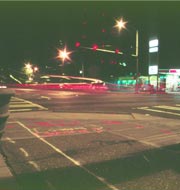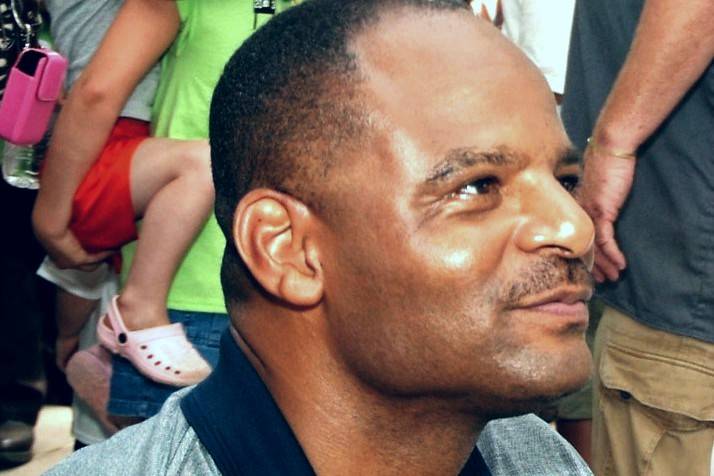A coroner’s inquest into the shooting of black motorist Aaron Roberts is set for Oct. 1 in King County District Court. Divorc鬠father, drug user, and ex-con, Roberts was killed May 31 by a white Seattle police officer after allegedly trying to drive off while dragging another white officer along the street. The fact-finding hearing and a jury’s advisory conclusion will help the county prosecutor decide if criminal charges should be filed. They virtually never are in police-shooting cases, although this emotional, racially-charged incident is expected to test that record (see “A Raw Time for Race,” p. 22). While no one will ever know exactly how events unfolded that night, we have compiled this narrative look at what appears to have taken place, based on the best evidence available through interviews, research, and private and public documents. Primary details come from the only participant who has released a statement, officer Greg Neubert. The statement of his partner, Craig Price, who did the actual shooting, is still under seal. However, some information from Price is revealed here for the first time.
THE BEGINNING
May 31, 2001. Aaron “Smokey” Roberts came down the narrow front steps of the Collins Gold Exchange, a 24-hour gold-buying smoke shop with security windows on 23rd Avenue East. It was 11:13 p.m., a cool Thursday evening. The well-packaged 5′ 7″, 210-pounder walked to a white 1990 Cadillac and climbed in. He put two fresh packs of cigarettes and some candy on the seat next to him, paid for by a winning $27 lottery ticket he’d bought earlier in the day. He was going to celebrate by taking his girlfriend to dinner. All in all, a mighty high profile for a man on the run.
The Cadillac engine revved. Among its driver’s prior convictions, dating to 1982, were four drug and theft felonies. To some, Aaron Roberts, 37, was a puzzle of contrasts—father of five children with two women, beloved by friends and family, yet described in court as a “high-risk re-offender, armed and dangerous, known to carry weapons.” He apparently had similar fears about police, once storing an armored vest in his bedroom should they break in to arrest him. In the mid ’90s, the former Garfield student seemed to be turning his life around, fending off drugs and finding meaningful work. But in January 2000 he was living in a rundown motel on East Marginal Way, a drug hangout, where he was arrested after his then-girlfriend said he beat her with a gun and took her money, $120. She later recanted her claim, but Roberts pled guilty to unlawful gun possession and earned a 43-month prison sentence in April 2000. After nine months he was moved to the downtown Seattle work-release program at the Reynolds Hotel. In January, he walked away.
He stayed out of trouble, his family provided a few dollars, and his mom lent him her car, the Cadillac. That brought him to this street, on this night.
Roberts began to back the long Caddy onto 23rd. The Gold Exchange’s customers park head-first into five small parking spaces and must reverse out. When he saw a break in the traffic, Roberts gunned the car tail first over the two south lanes and then into the two north lanes before he swung around on 23rd, heading north towards the East Union Street intersection.
Almost instantly, a police car bore down, also moving north on 23rd. The officer behind the wheel of the blue-and-white remembers he had to brake for the Caddy. He figured he might have a drunk driver in front of him.
“I immediately turned on all emergency lights,” recalls officer Greg Neubert, 35, “and initiated a traffic stop.”
Mustachioed, square-faced, Neubert had been on the force nine years. He had made his share of friends and critics, as most cops do. In plainclothes in 1995, he shot a drug dealer who pulled what turned out to be a gun-shaped cigarette lighter. The officer was cleared by a review board that said he “showed great restraint” (the dealer lived). Neubert once was suspended for blowing up at a commander. In his patrol district, young black men accused him of profiling and hassling them unjustly. Others thought the tough white cop’s kind of policing was what the neighborhood needed. A local restaurateur felt Neubert and his white cop partner Craig Price were instrumental in ridding her business of black drug dealers. The two officers were feared, she said, “but at the same time they are respected.”
When Neubert flipped on the emergency lights, the Caddy abruptly pulled into the right lane and stopped. Partner Price, 33, on the force two and one-half years, called in a radio warrants check on the car’s license. A former Marine lieutenant who served in war-torn Somalia, Price was now on duty in the east Central District. He stepped out onto the sidewalk and cautiously began moving toward the stranger he was about to kill.
Roberts’ driver’s side window was rolled down. Neubert greeted the man and said he’d been stopped for recklessly backing out of the driveway and impeding traffic.
Close up now, Neubert would later say he didn’t recognize him. But they had met before. Neubert and another officer had nabbed Roberts’ for the alleged robbery/assault of his former girlfriend.
The Jan. 8, 2000, arrest was made just a few blocks away, also late at night. Neubert drove Roberts to jail and booked him. On the booking form he noted Roberts had a tattoo on his right arm, sometimes used the name Eric (the name of his brother), and had $400 cash on him. Neubert also checked the “yes” box for “armed and dangerous.”
It was 11:15 p.m. “Driver’s license, registration, and proof of insurance,” Neubert said. He looked in the car for open drinks and weapons. Price was off to the other side.
Roberts said he didn’t have a license—nothing, in fact, with his name on it. He seemed pleasant, smiling at times.
“Everybody has something with their name on it,” Neubert recalls saying.
Roberts rummaged through the glove box and found the ownership record showing the car was registered in a woman’s name.
Neubert asked who the car belonged to. Roberts said “It’s my girlfriend’s car,” the officer recalls.
Neubert noticed that Roberts had the car in gear and both feet on the brake pedal.
Neubert told Roberts the exhaust fumes were bothering him. Could he turn off the car? “I phrased the request in a way not to alarm him of my observations,” that Roberts may intend to flee, Neubert says.
Roberts shifted into park but left the motor running. Neubert apparently did not insist the car be turned off.
The driver came up with some papers, Neubert remembers. The cop took them and the registration in his left hand.
Roberts seemed to be cooperating. Neubert would remember the driver addressed the cop by name—perhaps from his name tag. It all seemed routine.
But in 30 dizzying seconds, their worlds would change forever.
THE SHOOTING
As Neubert studied the papers, Roberts suddenly jerked the gear shift into drive with his right hand and in the next instant, using the same hand, reached over and grabbed the officer’s wrist holding the papers, Neubert recalls. His hand was outside; he never reached inside, the officer recalls.
It was a swift, and strange, maneuver, seizing a cop’s hand while presumably trying to get away from him. Did Roberts intend to drag Neubert? Pull him to the ground as he drove off? Or make a grab at the registration before he ran?
Roberts likely wasn’t thinking clearly at the time. Blood tests later proved that hours or days earlier he had shot up or ingested three separate drugs: ecstasy, morphine, and cocaine.
He could have panicked, too, maybe spotting Neubert right off and assuming the cop remembered him—or would, once he ran his name for warrants.
“Roberts clenched his right hand around my left wrist and pulled my arm into the interior of the vehicle,” Neubert recalls. The driver pulled the officer further in through the window as the car began to move, Neubert says.
Price bolted into action, running alongside the car and trying to call for backup officers. The Caddy would travel an estimated 150 feet forward and 50 feet backward before it was over. A witness who says she saw some events from a distance claims the car was rolling slowly, at walking speed, while police say Roberts hit the gas pedal so hard he left skid marks on pavement.
“The vehicle still continued forward, picking up speed as my feet began to drag on the pavement,” Neubert says. Fearing he might fall under the back tire—apparently unable to yank free of Roberts’ grip—Neubert pulled himself up and into the window, waist high, his head near Roberts’, he remembers.
He does not suggest, as some would later wonder, that he dove into the window on his own trying to grab the keys or gear shift to disable the car. Also contrary to other reports, Neubert indicates he was dragged only briefly (early media reports, relying on police-supplied information, said the officer was dragged a good distance, in one example “nearly one city block”).
From this point on, Neubert was apparently riding half-inside the car. At the same time, Roberts seemingly had let go of his wrist.
“I yelled for Roberts to stop several times as I reached for the gear selector with my left hand,” Neubert says. “I grabbed the gear selector and pulled it into park.” The gears ground, but the car kept moving.
Roberts began pummeling Neubert on the head with his left elbow, apparently now trying to knock him from the vehicle, Neubert recalls. The officer, stretched across in front of Roberts, used his right forearm to ward off the blows.
Neubert was shouting at Roberts to stop, he says, telling him he’d shoot. But he couldn’t get his hand outside the car to reach his gun, holstered on his right side.
As seconds flashed, officer Price was banging on the passenger side window, the officers recall, then Price jumped into the car as it rolled up to the 23rd and Union intersection.
“I can’t get free, I can’t get my gun!” Neubert said.
In the passenger seat, Price leveled his gun at Roberts, yelling “Stop!” and threatening to shoot, he recalls. Neubert was still grabbing at the gear shift. He rammed it into park again.
Momentarily, the car jerked to a stop. Neubert remained inside.
“Roberts then once again reached up and put the vehicle into drive,” Neubert remembers. “The vehicle lurched wildly then began to go in reverse. Roberts turned the steering wheel to the right,” causing the car to swing sharply and head backward toward the curb.
“I could now hear and feel the vehicle accelerating as we headed toward a building located on the southeast corner of 23rd and East Union,” says Neubert.
“I believe Roberts intended to hit something to throw me from the car.”
It was a mad, mad scene: Roberts shifting, steering, accelerating backwards, vision impaired by the policeman screaming in his face, with a loaded gun pointed inches from his side. Roberts also tried to grab the gun, the officers say.
“Roberts did nothing in any way to stop or slow the vehicle that headed toward the building,” Neubert says. “I yelled to officer Price to shoot two-three times as I feared a collision.
“I observed Officer Price with his duty weapon near the lower torso of Roberts, pointed toward the rear of the vehicle. I could hear the muffled sound of one gunshot. Shortly after the shot, I felt the vehicle hit the curb and a large three-foot-high cement planter.
“I was thrown from the vehicle and landed near the left rear,” he says, the Caddy high-centering on the concrete planter. Next to his head, he says, the rear tire was still spinning.
Within seconds, another officer arrived and dragged Roberts’ dying body from the car. At 11:17, medics were dispatched. The first units arrived at 11:20. Medics worked on Roberts for 19 minutes at the scene, then transported him. At 11:55, Roberts was pronounced dead at Harborview Medical Center. Neubert spent the night there. His injuries were minor.
At Roberts’ neighborhood funeral a week later, a pastor told the anxious, angry mourners: “When we don’t understand, please know that God is in total control.”
THE INVESTIGATION
Neubert gave a “basic overview” statement to detectives three hours after the shooting. The detectives say he told them he “ended up running next to the car.” There is no mention of being dragged. In his own written statement four days later, Neubert mentions it briefly.
Some events in the two statements differ chronologically, as do some in Price’s statement, police sources say. One insider calls Price’s explanations for his actions “surprising” in contrast with Neubert’s statement. Another says Price’s statement “just makes you want to ask, ‘Why in the hell did you do that?'” Neither Price nor Neubert explains why they were unable to turn off the car’s engine.
Also lingering is the question of why, when the car was jammed into park and the car stopped, Neubert didn’t bail. Did he, in the split-second decision making required, decide he was safer stuck in the window? Or was he aggressively trying to stop Roberts from fleeing?
A crucial point is Roberts’ omnipresent hands—seemingly in four places at once during one overlapping point. Neither officer has explained this apparent conflict.
Of course, that’s what an inquest is for. If all goes as planned, those questions will be answered shortly. One catch: There will be just two primary witnesses—Officer Neubert and Officer Price. Only they, and Aaron Roberts, saw it all. Now only they can tell what happened.









